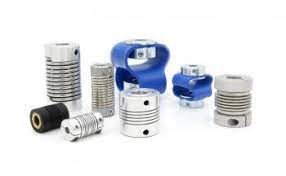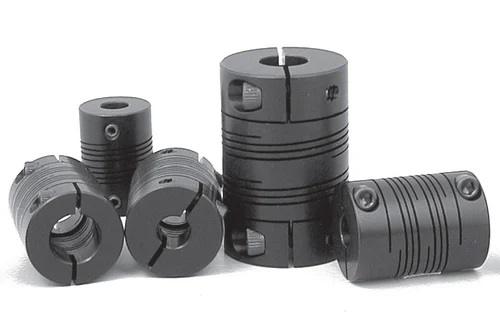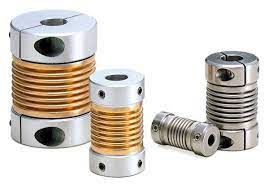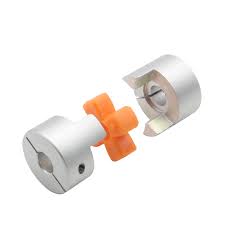Encoder coupling types
30.06.2023
An encoder is a device that can be used to determine the angle of rotation of a rotating object by issuing a pulsed digital code. It is used to determine the speed of rotation of a shaft (axis) when it is not necessary to maintain the absolute angular position when the power is turned off. In other words, when the shaft is stationary, the transmission of impulses stops.
That is, when an encoder of this type is turned on, the angle rotation count will start from zero and not from the angle to which it was set before it was turned off. The axis of the encoder and the object are fixed to each other by a special transitional flexible coupling. Alternatively, the encoder can be mounted on a shaft if the encoder has a hollow shaft.
When connected with a coupling, in case of misalignment, and in case of expected runout, they are eliminated by deformation of the flexible sleeve. Today we will take a closer look at different encoder coupling types.

What Is an Encoder Coupling?
The coupling is a mechanical element that connects two shafts together to accurately transfer power from the driving side to the driven side, compensating for mounting errors (misalignment), etc. of the two shafts.
A coupling in mechanical engineering is interpreted as "the part that connects two shafts together" and is commonly referred to as a "clutch", "shaft coupling" or "hinge". Power can be transferred using a clutch even between axles of different diameters.
Benefits of encoder couplings.
- Encoder sleeves are chemical and oil resistant.

- Minimized backlash.
- Full compensation of eccentricity, axial and angular movements due to the radial spring.
- High-strength aluminum alloy guarantees high torque and inertia-free transmission.
- Combined execution of couplings made of aluminum alloy and stainless steel grades is possible.
- Optimized for high-speed applications, they provide the necessary alignment accuracy and minimum moment of inertia.
The use of couplings.
- Shaft sensor.

- Tachogenerator.
- Stepper and synchronous motor. Encoder sleeve
- Encoder connection
- damper drives.
- Rotary encoder.
Types of Encoder Couplings
There are three main subspecies of encoder shaft couplings. Now let's look at them in more detail.
Flexible couplings
Any shaft couplings that can allow some degree of relative motion between multiple shafts and provide vibration isolation are known as flexible couplings. If the shafts were perfectly aligned at all times and the machines did not move or vibrate during operation, there would be no need for a flexible coupling.
Unfortunately, this is not how machines work in reality, and designers have to deal with all of the above problems when designing machines. For example, CNC lathes place high demands on accuracy and speed in order to perform high-speed machining operations. Flexible couplings can improve productivity and accuracy by reducing vibration and compensating for misalignment.
These couplings can reduce the wear and tear of machines through the imperfections and dynamics that are part of almost every system. As an added bonus, they tend to be fairly easy to install and have a long lifespan.
Rigid couplings
Rigid couplings are a type of coupling that should only be used when the shafts are exactly in line. A rigid coupling is only suitable for shafts that are closely aligned or held in alignment. Otherwise, the torque will be transferred to the shafts and bearings, which can lead to premature failure. Unlike most other types of couplings, there is no flexible element in a rigid coupling.
There are three main types of rigid couplings: coupling, flange, and clamp. For industrial shafts, a rigid coupling may be a sleeve with press-fitted shafts at each end or maybe a clamping sleeve. The sleeve at each end of the shaft may have an external flange with bolt holes. Couplings for heavy-duty machines are bolted together to hold shafts rigidly; therefore the shafts must be precisely aligned before assembly.
Hybrid couplings
Hybrid couplings are one of the most suitable designs for use with encoder drives. The design combines high torsional rigidity, angular flexibility, and axial compliance, and also compensates for parallel misalignment depending on the number of corrugations. They also offer a low moment of inertia and can transmit rotational motion without cyclic errors or backlash.
In general, a hybrid coupling is more reliable and able to transmit more torque with more shaft displacement. In this regard, electrodeposited nickel sleeves are claimed to provide superior performance. Hybrid couplings are somewhat vulnerable to external physical damage; for example, careless use of hand tools during maintenance or assembly work can result in scratches or dents that degrade performance.
Factors to Consider When Selecting an Encoder Coupling
The need for ever lighter connectors with less inertia increases with the productivity of the equipment. On the other hand, an increase in the specific power and torque of the drive technology is required. So how do you choose one of the appropriate encoder coupling types?
We recommend using a four-step approach when deciding which encoder connection to use in an encoder application.
- Type - First of all, you should select the type of coupling. The choice of coupling type should take into account the physical characteristics specific to the application.
- Material – The operating environment is the main factor influencing this decision.
- Size - The dimensions of the two shafts connected together, as well as the distance between them, are some of the points to consider.
- Mounting method - There are 2 main methods: the set screw method and the clip method.
Torsional stiffness is the ability to resist twisting. This is important for encoders because they measure rotational motion. If the coupler is allowed to "twist", this means that there may be a rotational misalignment coming from the drive shaft that is not transmitted to the encoder. Therefore, the measured rotation may not be accurate. For high accuracy, a zero backlash coupling (high torsional rigidity) is recommended.
Another important characteristic is the ability to compensate for misalignment. Displacements can occur during installation (static) and during operation (dynamic). Selecting a coupling capable of handling these displacements is important to prevent premature coupling failure and/or damage to the encoder bearing.